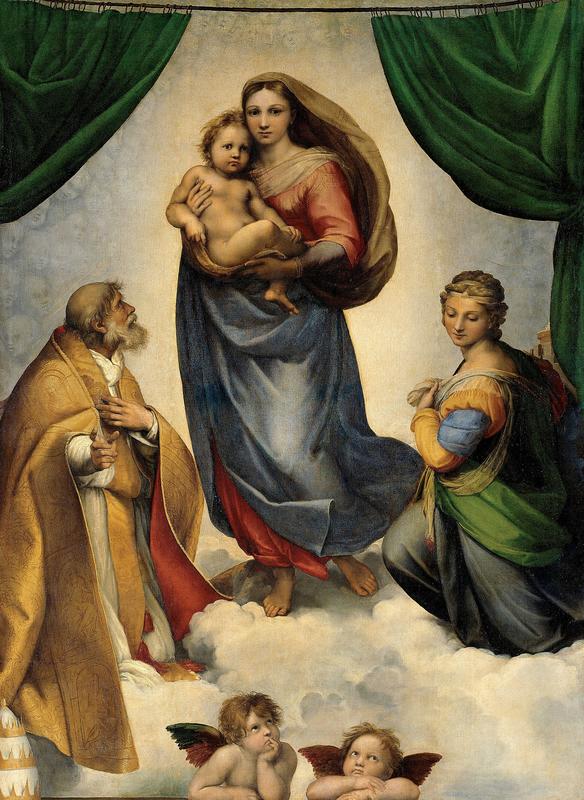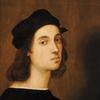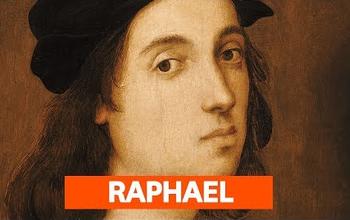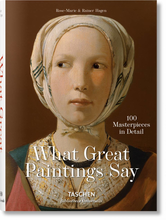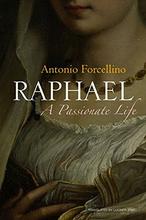More about The Sistine Madonna
- All
- Info
- Video
- Shop

Contributor
This was the last, and arguably best, painting Raphael made before his untimely end at age 37.
Images of the cherubs at the bottom have been used on U.S. postage stamps, t-shirts, dinnerware, wrapping paper, and for the logo of the iconic 1970’s fashion brand Fiorucci. One story claims the cherubs are the children of Raphael’s model for the Madonna. Another one that Raphael found them on the street looking into a bakery window, so he took them to his studio and made them recreate the pose. We hope it's the former because we don't want to think of one of the greatest artists of all time as a creepy pedo. Like, did they not have stranger danger in the 16th century?
According to German legend, Rafael got the template for the Sistine Madonna directly from God in a heavenly vision. Germans throughout history have been fanatically devoted to the painting. Goethe, Wagner, and Nietzsche all claimed inspiration from it. Unfortunately for them, the Russians took the painting from the Germans as a war trophy in 1945. It hung in Moscow for a decade before they gave it back in gesture to "strengthen the friendship" between East Germany and Russia.
There is controversy about whether the Russians saved or stole the painting in WWII. They claimed to have found Sistine Madonna in an underground storage tunnel. The Germans had stashed it away to prevent it from being pulverized by the U.S. airforce, along with the rest of Dresden. The Russians argue that water and mold in the tunnel would have destroyed the canvas had they not come to the rescue. Some eyewitnesses disagree. They suggest the tunnel was dry and that the humidity and temperature control equipment was working perfectly. Maybe a spoil of war rather than a spoiled painting...

Featured Books & Academic Sources
The following is an excerpt from "Raphael: A Collection of Fifteen Pictures and a Portrait of the Painter with Introduction and Interpretation" by Estelle M. Hurll, published in 1899:
As we turn to the picture, famous the world over as the Sistine Madonna, we seem to be looking through a window opening into heaven. Faint in the background, yet filling the whole space, is a cloud of innumerable cherubs; out of this cloud, and enveloped by it, appear the Mother and Child.
They are taking their way seemingly from heaven to earth. A curtain has been drawn aside that we may see them, and two figures are on either side, as if to await their passing, one gazing into their faces while he points outward, the other also kneeling in devotion yet looking intently down. The mother's robes are blown back by the wind as she moves steadily forward.
Underneath is a parapet, as if this were indeed a window, and two beautiful boy-angels lean upon it, adoration on their faces and rest in their position, as if they were everlastingly praising, and were the very embodiments of cheerful innocence.
It is worth while to look at this picture for a moment, without thinking of its meaning, and indeed without paying much attention to the beauty of the figures, just to see how this great painter has managed the lines and masses of the work. In art, lines and masses and color are not unlike what words and sentences and what we call style are in literature. Even if a writer has good and beautiful ideas, much of the pleasure we might derive is lost when the words are ill chosen, the sentences are bungling, perhaps even ungrammatical, and the whole expression is commonplace or confusing.
We cannot get any notion of Raphael's color from our little print, but it is not difficult to trace the lines and to see something of the effect of the masses, and of light and shade. The shape of the whole is a combination of pyramids. When you see the great base of a pyramid and observe how the sides taper upward, you are aware that nothing could stand more securely and at the same time suggest lightness, by the rising and receding of the sides.
Now here you see that lines drawn from the shoulders of the two attendant figures would meet at the Virgin's head, as at the apex of a pyramid. The curtains even help this effect, by being drawn aside in such a way as to make these lines more evident.
In the lower half of the picture the lines in the draperies of the kneeling saints taper to an imaginary point between the heads of the cherubs, forming a second inverted pyramid or triangle. Thus the composition is inclosed in a harmonious figure whose outlines suggest what we call a diamond.
Perhaps one reason why a triangular arrangement satisfies the eye, lies in the simple fact that the most important and yet familiar object in nature is thus arranged. Thus in this picture, the three principal persons form the upper triangle, and the body of each person repeats the figure,—that is, the head rises from the shoulders in such a way that the lines inclosing them produce a triangle. Further, in each face, the line formed by the eyes is connected by two imaginary lines meeting at the mouth.
In the picture the central figure illustrates this very noticeably. The arm of the Virgin forms by its position, along with the body of the child, a base, from which two other lines rise, tapering to the top of the head; the child's head lies right in the course of one of these lines. Thus mother and child together form a single figure, the two united in one.
But when we have studied this simple principle of composition, we go back with delight to the picture itself for what it tells us: the deep mystery of the mother's face, as if she were lifted above the ordinary plane of human life; the blended loveliness of childhood with the consciousness of a holy calling; the lowly devotion yet dignity of St. Barbara; the grandeur and forgetfulness of self of the Pope, whose triple crown rests on the parapet; the perpetual childhood of the angelic figures.
The picture takes its name from the Pope, who had been canonized as St. Sixtus. It was painted for the convent of St. Sixtus at Piacenza, but early in the eighteenth century it was bought by the Elector of Saxony, and now hangs in the gallery at Dresden. It is a pleasant thing to know that when Frederick the Great bombarded Dresden, he ordered his cannon to keep clear of the Picture Gallery. Napoleon, too, though he took many pictures to Paris, did not take any from the Dresden gallery.
When we compare the Sistine Madonna with the Madonna of the Chair, we see what a wide variety of pictures there may be on the single subject of the Mother and Child. The Madonna of the Chair is, as we have said, a home scene, like a picture from real life. The Sistine Madonna is a vision; the figures are lifted above the actual surroundings of earth into a purely ideal and heavenly atmosphere. In the Madonna of the Chair, the Mother and Child are all in all to each other, and what attracts us most in the picture is the mother's love. In the other picture both mother and boy seem to forget themselves in the thought of some glorious service to others.
Sources
- Hurll, Estelle M. "Raphael: A Collection of Fifteen Pictures and a Portrait of the Painter with Introduction and Interpretation" (Boston and New York: HOUGHTON MIFFLIN COMPANY, 1899.) 85-90
Featured Content
Here is what Wikipedia says about Sistine Madonna
The Sistine Madonna, also called the Madonna di San Sisto, is a oil painting by the Italian artist Raphael. The painting was commissioned in 1512 by Pope Julius II for the church of San Sisto, Piacenza, and probably executed c. 1513–1514. The canvas was one of the last Madonnas painted by Raphael. Giorgio Vasari called it "a truly rare and extraordinary work".
The painting was moved to Dresden from 1754 and is well known for its influence in the German and Russian art scene. After World War II, it was relocated to Moscow for a decade before being returned to Germany.
Check out the full Wikipedia article about Sistine Madonna

